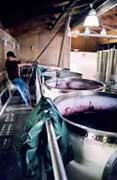California Wine Facts and Figures
SAN FRANCISCO - California is the leading wine producing state - making more than 90 percent of all U.S. wine - and also ranks first in wine consumption. Californians enjoy nearly one in five (18 percent) of the bottles consumed in the United States. If California were a nation, it would be the fourth leading wine-producing country in the world behind France, Italy and Spain. With this great culture of wine, there is significant interest in all aspects of the grape. As the voice for California wine, Wine Institute offers the following fun wine facts:
Good news for the waistline!
Wine is fat free and contains no cholesterol. A 4-ounce glass of table wine has about 80-100 calories.
Just how many grapes are in that bottle of wine?
It takes about six to eight clusters, or approximately 600 to 800 wine grapes (2.4 lbs), to make a bottle of wine.
One barrel of wine contains 740 lbs of grapes, equivalent to 59 gallons or 24.6 cases of wine.
And how many bubbles in a bottle of bubbly?
It is theorized there are approximately 44 million bubbles in a bottle of sparkling wine/champagne.
What's on top in 2004?
Chardonnay, with 96,500 acres, is the wine type variety with the most acreage planted in California.
Cabernet Sauvignon was the second most planted winegrape in California with 74,900 total acres.
For the first time in recent history, the red wine category edged out white wine by volume in food stores in 2004. Red held a 40.5 percent market share; white, a 40.4 percent share; and blush accounted for 19.1 percent share of case volume, according to ACNielsen.
Chardonnay remained the leading varietal wine, followed by Merlot, White Zinfandel and Cabernet Sauvignon. Together these four varietals made up over half (55 percent) of the wine sales in food stores.
Variety is the spice of life in the Golden State
Wine-type grapes are grown in 46 of California's 58 counties, covering 513,000 acres in 2004.
There are more than 93 American Viticultural Areas (AVAs) in California (distinct winegrape growing areas recognized by the U.S. government), a testament to the variety of microclimates in the state. California has 93 of the 165 AVAs established in the U.S.
California wines have benefited from the unique and varied mix of cultures that found new homes in the Golden State. From Spanish missionaries who established the state's first vineyards and wineries beginning in 1769, to the German, Italian and other European immigrants who founded California's pioneer wineries, and to the farmers, researchers and entrepreneurs who helped create the modern California wine industry.
The highest vineyard in California is the Shadow Mountain Cabernet Sauvignon vineyard located at an elevation of 4,400 feet above sea level in the mountains of San Diego.
California's 1,300 bricks and mortar commercial wineries are predominantly family-owned and operated.
There are more than 60,000 registered California wine labels.
Sustainable wine practices take root
The trend in sustainable winegrowing and winemaking practices is growing quickly in California. Vintners and growers who represent 40 percent of the annual wine case production and one quarter (125,000 acres) of the state's wine acreage currently participate in the Code of Sustainable Wine Growing Practices program.
California wine is good for the bottom line
California wines accounted for 64 percent of the total 668 million gallons - both foreign and domestic - consumed in the U.S. in 2004, or roughly two out of every three bottles sold in the country.
California winery shipments comprised roughly $15 billion of the $23 billion estimated retail value of all wine sold in the U.S. in 2004.
Wine is California's most valuable finished agricultural product. The overall economic impact of the wine industry on the economy of California exceeds $45.4 billion.
The expansion of exports of California wine over the last decade has dramatically increased from $196 million in 1994 to $794 million in 2004.
Second only to Disneyland
Wineries and vineyards are the second most popular tourist destination in California after Disneyland. A total of 14.8 million tourists visit the state's wine regions each year.
Wine Gains Momentum
In a recent Gallup Poll, Americans named wine as the alcoholic beverage they drink most often for the first time. Wine consumption among U.S. adults 21 years and older is 3.06 gallons (about fifteen 750 ml. bottles) per person per year.
If you want to comment on this or any other pages on this site please use the Cellar Room. If your category isn't listed, make one up.
Last update January 2026. Santa Barbara.
The current local time is 05:50:57 pm
:: Content ©2006 admin@sbwinemakers.com ::
:: Videography ©2006 admin@sbwinemakers.com ::


